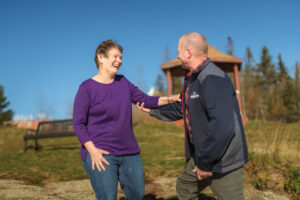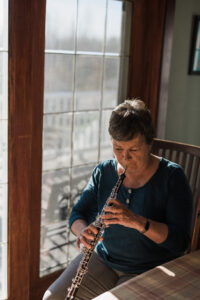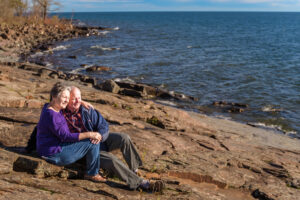Karen | Living with HCM due to the MYBPC3 mutation
Duluth, MN | Born September 1958
This is the fourth generation in my family diagnosed with HCM, though we think it goes back much further.
Karen tip-toes carefully through a field of small boulders and rocks on the way to one of her favorite beaches, the sound of splashing water getting closer with each step. Her husband, Bob, outstretches his hand and helps her down onto the rocky coastline. The couple takes their time, enjoying the relative calm and looking out over the water. It would be easy to think one was on the ocean here, but they are in fact on Lake Superior, just minutes from the couple’s home in Duluth, Minnesota, where they’ve resided for the past 40 years.
The cool fall air heralds the coming of winter from the northwest making swimming even less tempting than it is at the height of summer. The water in Duluth never surpasses 68℉, a constant reminder of the deep cold that resides in this place. But Karen loves the beach all the same, and going on walks on the Lakewalk trail system along Duluth’s shoreline. She fondly recalls the times that she’s taken her grandson, Sam, to this very spot—and the sounds of glee as he tossed stones into the waves.”
Sam makes the trip every year from Southern California. The rambunctious eight-year-old fills the house with a youthful energy that was once the norm for Karen and Bob when they raised their five children, now all adults with children of their own. Sam is now one of 10 grandchildren. His visit comes annually as he and his father, Joe, travel each summer to Mayo Clinic for tests, a five-hour drive from Duluth. There, they meet with a team of cardiologists who specialize in treating hypertrophic cardiomyopathy (HCM), a heart disease that Karen, her son, Joe, and her grandson, Sam, all share.
HCM causes a pronounced enlargement of the cardiac muscles of the left ventricle as well as the interventricular septum, which can lead to arrhythmias and heart failure, symptoms that countless members of Karen’s family have dealt with over the years. “This is the fourth generation in my family who are being diagnosed with HCM,” states Karen, “even though we think it goes back much further.” Generations before she was born, on her father’s side, there was a series of sudden cardiac deaths that went unexplained. It wasn’t until Karen’s generation that more advanced diagnostic and imaging tools availed HCM diagnoses. Sam is the first in the family to be diagnosed at an age of just five years old. Karen worries that he also has a more severe case, as at this tender age the thickness of his heart wall is even greater than what one would expect to see in adults.
These worries have permeated much of Karen’s life as she and her immediate family members began to recognize and then manage their lives with HCM. However, Karen’s levity and her affable nature, contrast the depth of hurt caused by this limiting disease. There have been losses, major ones, and everyone has had their fair share of scary moments, but Karen refused to let her condition define her personality.
“We don’t like to dwell on the disease,” Bob chimes in. He and Karen have been married for over 40 years, long before she knew that she would develop HCM. “We have the life we have and we’re going to make it as good as we can for as long as we can.” He and Karen have both found a balance between the necessary doctor’s appointments and precautions and a deep desire to make use of the time they have on this earth, knowing at any moment, things can drastically change.
Karen grew up the youngest of four to her parents, Ercil and Irene, in Colorado Springs, Colorado. Her unenviable position as the only daughter meant that she was often picked on. “My brother, Larry, used to tease me a lot,” she recalls. But he didn’t stop at only giving flack to his sister. “He was kind of the impish one. He had gotten himself locked in a locker in high school, and a teacher walked by and heard him inside. She asked, ‘Is that Larry?’ and when he said yes, she said, ‘I thought so,’ and kept walking.”
Karen got along well with her oldest brother, Ron. “I would tutor him when he was in high school,” she remembers. Ron was born with a developmental disability and always appreciated her assistance. He was also the first to reach certain memorable milestones, notably buying his first car. “He got this red and white Bronco that he absolutely loved,” remembers Karen. Ron loved his “vehicle” as he called it, and it facilitated his entrance into the workforce.
Larry was the first sibling to learn that something was awry with his heart. At 16 years old, he attended a physical that was required to participate on the high school wrestling team. The results of that exam led to cardiologists getting involved and Larry soon found himself at the hospital undergoing tests and imaging. When doctors saw the abnormally large walls of his heart, he was diagnosed with idiopathic hypertrophic subaortic stenosis, an older classification of HCM. “He was told he could live to be 100 or die the next day,” recalls Karen. Surgery was a potential option, but after a second opinion, he opted to take medication instead.
Larry married young, and he and his wife were expecting their first child in 1976 when he took a job up in Wyoming working with a land surveying company. That April, while out surveying, one of his co-workers left their field glasses back at the truck and Larry offered to retrieve them. He strode away but didn’t return for what seemed like a long time. His crew walked back to look for him and found Larry on the ground. His heart had stopped and he was dead at 20 years old.
Karen was still in high school at the time of Larry’s death, only weeks from graduation. “I don’t really remember the last two months of my senior year,” she says. Larry left behind a fledgling family of his own: his wife JoAnne and his daughter, Audra, who would never meet her father, but did inherit the same genetic disease that took his life. The grief from his death transformed Karen just at the cusp of entering the adult world. “I had a different life experience at that point than most kids going off to college… Most kids that age have a feeling of invincibility. They don’t have that life and death thought. Suddenly I did. It was very real to me. I realized, even at my age, death was a possibility.”
Larry’s sudden death prompted testing for HCM in the rest of Karen’s immediate family. Karen got her first echocardiogram, and fortunately physicians could find nothing wrong. However, Karen’s father showed many markers of the disease, and Ron, seemingly young and healthy, was also diagnosed with HCM.
With a clean bill of health, at least for the moment, Karen quickly transitioned from a young woman into a wife and mother. At 19 years old she met Bob, an Air Force cadet from northern Minnesota, and the two started dating. “I was more interested in pursuing the relationship than she was,” he says jokingly. However, things moved quickly and a year later they got married. Bob’s marriage effectively disqualified him from continuing as a cadet, and so he moved to finish his degree in Spokane, Washington. Karen traveled with him and, a year later, the two decided to return to Bob’s home in northern Minnesota.

“I wanted to be a special education teacher,” says Karen. However, with the marriage and the birth of her first of five children, Karen put her aspirations on hold and focused on raising her own sons and daughters. “I decided I could have enough patience to either be a special ed teacher or be with my own children,” she says. “I couldn’t do both.” However, Karen continued to help with Bob’s business acquisition. An eager entrepreneur, he purchased a medical supply distributor, and despite knowing little about the field, developed a successful company, eventually transitioning to selling accessibility and mobility supplies.
Karen eventually returned to her original career plan. “I decided to become a kindergarten teacher,” she says laughing, “because you don’t need any patience for that!” Her love of teaching continued for decades, and still today she works for a local diocesan school as a substitute, which keeps her quite busy.
Just when it seemed that adverse health events were potentially a thing of the past, Karen’s life would again be forever changed by HCM. In 1986, 10 years after Larry’s death, Ron suddenly collapsed at his job and died from sudden cardiac arrest. As her family came together to grieve the loss of Ron, Karen’s sadness began to transform. She could no longer sit back and wait for things to happen to her and other valued members of her family—she would need to be more proactive.
Family history plays a vital role in understanding and diagnosing HCM, and for Karen, the blows of discovering the extent of HCM in her family and her own eventual diagnosis were somewhat softened by her doctor’s preemptive care plan, including regular monitoring and genetic screening. “There were a lot of fortuitous events,” she says, a tinge of awe in her voice. In Duluth, Karen had a neighbor who happened to be a cardiologist and had a daughter with HCM. “He asked me if I had been screened recently? If my kids had been screened?”
Karen responded promptly and started getting her and her kids regularly examined starting in 1996. She found out that her son, Joe, had a borderline case—his heart was thicker than normal. Meanwhile, her father began to experience symptoms of HCM with age and she had to step up to help manage his care from afar as his condition began to worsen, eventually undergoing surgery to place an implantable cardioverter defibrillator (ICD) in 1998 to help address his irregular heart rhythms. Karen and her family started seeing an HCM expert at the Minneapolis Heart Institute, who would prove crucial in the coming decades.
This care proved lifesaving for the family. “The challenge of HCM is its unpredictability,” Karen relays. “You never know how it is going to affect members even within the same family.” In 2003, Joe passed out before a college pick-up basketball game. Syncope, or sudden loss of consciousness, is a common and frightening symptom of HCM, but fortunately, Joe’s heart never stopped beating. It was, however, determined that it would be best if he too had an ICD placed, which he did that summer.

It was at her screening that year Karen was finally diagnosed with HCM as well. She was relatively nonplussed by the news. “My doctor was kind of surprised I wasn’t more shocked or upset,” she says. “I was just happy it was me and that it wasn’t another of my kids.” Furthermore, her doctor recommended she get an ICD placed. “The decision was made solely on the family history,” she explains, “which was quite unusual at that time.” She had never experienced any symptoms herself, but trusted her doctor and took his advice.
Fourteen months later, Karen awoke with a start at 5:30 A.M. “I felt like I was having this dream where I was falling, and then woke suddenly.” As she would soon find out, her ICD had gone off, sending a shock to correct a potentially deadly arrhythmia in her heart. “I knew it was the ICD,” says Bob. “If it hadn’t been for my doctor recommending the ICD, I wouldn’t have lived through that night,” says Karen, the realization still fresh in her mind. “I’m very grateful for all the events that led up to that.”
In the coming years, her ICD went off more often, and Karen experienced her first symptoms of HCM. “With all 10 of my shocks, I haven’t felt a single one,” says Karen. “I’ve been either asleep or had syncope [fainted] before it shocked me.” The shocks and syncope accompanied a worsening of her overall physical condition. She started having trouble climbing the stairs—wearing out long before she normally would.
Most frustrating for Karen was her lack of breath for playing her oboe, a woodwind instrument that she had played for decades in a community band. “My band director was frustrated with me,” Karen recalls. Despite playing the double-reed instrument for most of her life, she had to stop performing with the ensemble. “That was a very sad day,” she laments. “I realized in the middle of a rehearsal that I just couldn’t do it anymore.”
Karen first attributed the lethargy to a new medication she was taking, but her doctor knew that wasn’t the case. Her genetic cardiomyopathy had become obstructive and she was in the early stages of heart failure. “Once I learned that, I knew I would likely need an operation.” Karen educated herself about what it would mean to get a septal myectomy, and in 2010, she underwent the procedure.
The operation was a success. Within weeks, she began to regain energy. She could walk with her students to chapel once a week, she ascended the Arc de Triomphe in Paris, on a vacation with Bob, and she began playing oboe with the band again.

“We don’t want to be late,” Bob mentions as the evening wears on. Karen has band rehearsal, and if she shows up late, it’s often him who gets the flack. Over the past decades, he has gotten the chance to see Karen perform dozens of times with the band. “Our conductor likes to do themed shows,” she explains. Composers of Britain, Finnish music, songs about the sea—these have all been motifs that Bob has listened to, time and time again, at home and at the concert venue two miles from their house.
The rose garden is bereft of flowers this late into the fall, but the grounds speak to a beauty and wealth of experience that Karen and Bob have shared over the years. Getting to see concerts outdoors here has certainly been a treat through the long months of the pandemic, featuring many of Duluth’s talented musicians.
Since Karen’s myectomy, over 10 years ago, she has continued to live a life forever changed by HCM, but by no means transformed beyond recognition. “Karen’s always been someone with the ability to balance,” says Bob. “Being adaptable without abandoning who she is and what she wants. I’ve grown to appreciate that more and more over the years, especially since we’ve had family move away as we’ve gotten older.”
Karen sees much of this as a reflection of the consistent, high-quality care she’s received, “I feel very privileged,” she says. “There are people around the world with HCM and I have had the best care out there.” She hopes that access to many of the treatments that she has received will become more available throughout the world.
The best medicine and care have greatly improved Karen’s life, but it has not stopped the prevalence and eventual disturbances wrought by HCM. Loss has persisted: her father passed away from congestive heart failure (due to HCM) in 2015. Now, two of her children and one of her grandchildren have the disease, as well as her niece, Audra, who lost her father to the illness. Together the picture can be seen as tragic.
But the trend is changing. Advancements and innovation are giving Karen and her relatives reasons to be optimistic. “I’m very thankful to be in this moment,” she says, reflecting on the high quality of care she’s received. “But I hope they will come up with more ways to address or even cure HCM. I’m hoping by the time our grandkids get older something will be there.” Bob too, has an immense appreciation for the depth of care that Karen has had access to. “Her chance of dying of cardiac death is likely lower than the rest of the population,” he says, astonished. “She is walking around with a defibrillator.”
Karen’s ineffable smile hints to a deeper transformation, one greater than sadness or grief could ever penetrate. “Every time my ICD goes off, I recognize that I could’ve died then,” she says. “I just had my life saved and I’ve had my life saved not once, not twice, but 10 times. What am I going to do with that time I’ve been given? There’s a reason that I am still here.”

